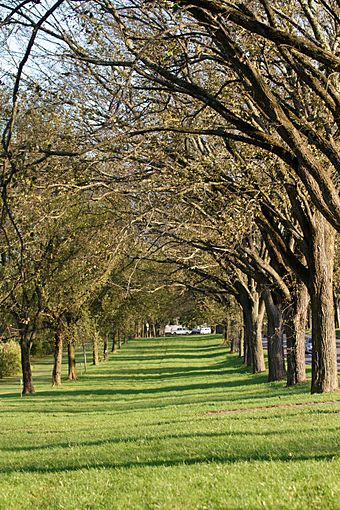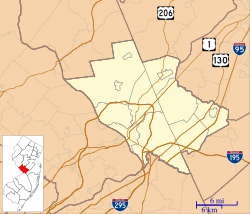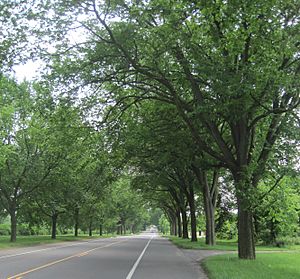Washington Road Elm Allée facts for kids
|
Washington Road Elm Allée
|
|

The easternmost of the triple allées, facing south toward U.S. Route One
|
|
| Location | Washington Road between the Delaware and Raritan Canal and U.S. Route One |
|---|---|
| Area | 6 acres (2.4 ha) |
| Built | planted mid-1920s |
| Architect | Princeton nurseries |
| Architectural style | Tree avenue |
| NRHP reference No. | 98001571 |
Quick facts for kids Significant dates |
|
| Added to NRHP | January 14, 1999 |
The Washington Road Elm Allée is a beautiful, tree-lined road in West Windsor, New Jersey. It stretches for about 0.7-mile (1.1 km) along Washington Road. This special road is famous for its many Princeton Elm trees.
The allée (which means a tree-lined path or road) runs through fields owned by Princeton University. It creates a grand and impressive entrance to the university campus, especially with the bridge over Lake Carnegie. At the northern end of the allée, you'll find the Delaware and Raritan Canal. There's also a jogging path here that connects to other trails, including the canal's towpath and paths leading to the main university campus.
Contents
History of the Elm Allée
Planting the Trees
The first trees in this allée were planted in the mid-1920s. They were put there by Princeton Nurseries, which was once the biggest plant nursery in the United States. The Elm trees you see are a special kind called 'Princeton Elms'. Princeton Nurseries developed them because they look great and, more importantly, they can resist Dutch elm disease. This disease has sadly killed many elm trees around the world. The Princeton Elm is one of the few types that has grown to full size and stayed healthy.
Out of the 136 original Elm trees planted almost a hundred years ago, 76 are still standing today. These old trees are quite large, about 24–26 inches (610–660 mm) wide and 60 feet (18 m) tall. Their branches reach over the road, forming a cool, leafy tunnel. Over the years, new trees have been planted to replace some that didn't survive. These include 16 Norway maples from the 1960s and 31 'Liberty Elms' planted in 1995. Other rows of trees, like 'Delaware Elms', were added in 1983. There's also a long line of forsythia bushes, which are thought to be from the late 1960s.
Schenck-Covenhoven Burial Ground
If you walk along the jogging path to the east of the Elm Allée, about 1,100 feet (340 m) from the road, you'll find a very old cemetery. It's called the Schenck-Covenhoven Burial Ground, but some people call it the Old Conover Graveyard. This cemetery has about 40 to 50 graves surrounded by a stone wall. It's definitely the oldest cemetery in West Windsor Township, with some burials dating back to at least 1751.
The Schenck and Covenhoven families were Dutch farmers. They bought a huge area of land, about 6,000 acres (2,400 ha), in what is now West Windsor back in 1737. The Conover family was among the first people to settle in Penns Neck, a community located at the south end of the allée. This cemetery hasn't been used for burials for over a hundred years, but Princeton University helps to keep it maintained.
Images for kids









